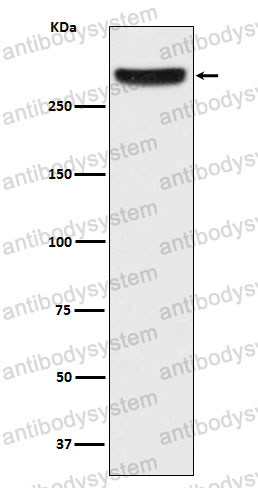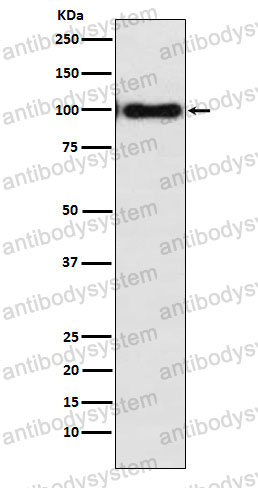Catalog No.
RHG85301
Species reactivity
Human, Mouse, Rat
Host species
Rabbit
Isotype
IgG
Clonality
Monoclonal
Tested applications
IHC: 1:100-1:200, IP: 1:20-1:50, WB: 1:1000-1:2000
Target
Inositol 1,4,5-trisphosphate receptor type 1, INSP3R1, IP3R 1, ITPR1, InsP3R1, Type 1 InsP3 receptor, Type 1 inositol 1,4,5-trisphosphate receptor, IP3 receptor isoform 1
Concentration
1 mg/ml
Endotoxin level
Please contact with the lab for this information.
Purity
>95% by SDS-PAGE.
Purification
Protein A/G purified from cell culture supernatant.
Accession
Q14643
Applications
IHC, IP, WB
Form
Liquid
Storage buffer
0.01M PBS, pH 7.4, 0.05% BSA, 50% Glycerol, 0.05% Sodium azide.
Stability and Storage
Use a manual defrost freezer and avoid repeated freeze thaw cycles. Store at 4 ℃ for frequent use. Store at -20 ℃ for twelve months from the date of receipt.
Clone ID
R2F62
Chronic vertigo and central oculomotor dysfunction with evidence of anti-ITPR1 antibodies., PMID:39891750
Autoimmune brainstem encephalitis: Clinical associations, outcomes, and proposed diagnostic criteria., PMID:39708293
Impact of anti-PD-1 therapy in a melanoma patient with paraneoplastic anti-ITPR1 encephalitis., PMID:38061970
Autoantibodies against Central Nervous System Antigens and the Serum Levels of IL-32 in Patients with Schizophrenia., PMID:36122562
Inositol 1,4,5-trisphosphate receptor type 1 autoantibody (ITPR1-IgG/anti-Sj)-associated autoimmune cerebellar ataxia, encephalitis and peripheral neuropathy: review of the literature., PMID:35907972
Paraneoplastic encephalomyeloradiculits with multiple autoantibodies against ITPR-1, GFAP and MOG: case report and literature review., PMID:34635185
Neurological Autoimmunity Associated With Homer-3 Antibody: A Case Series From China., PMID:34580182
Confabulation, amnesia and motor memory loss as a presentation of apparent ITPR1 antibody autoimmune encephalitis., PMID:34531236
Update in Autoimmune Movement Disorders: Newly Described Antigen Targets in Autoimmune and Paraneoplastic Cerebellar Ataxia., PMID:34489848
Purkinje cell (PC) antibody positivity in a patient with autoimmune glial fibrillary acidic protein (GFAP) astrocytopathy., PMID:33287611
Neurochondrin Antibody Serum Positivity in Three Cases of Autoimmune Cerebellar Ataxia., PMID:31179511
Paraneoplastic cerebellar degeneration associated with anti-ITPR1 antibodies., PMID:28203616
Diacylglycerol kinase ε localizes to subsurface cisterns of cerebellar Purkinje cells., PMID:28191598
Selaginella uncinata flavonoids ameliorated ovalbumin-induced airway inflammation in a rat model of asthma., PMID:27916586
Inositol 1,4,5-trisphosphate receptor type 1 autoantibodies in paraneoplastic and non-paraneoplastic peripheral neuropathy., PMID:27776522
Sulforaphane-induced apoptosis involves the type 1 IP3 receptor., PMID:27528021
Screening for MOG-IgG and 27 other anti-glial and anti-neuronal autoantibodies in 'pattern II multiple sclerosis' and brain biopsy findings in a MOG-IgG-positive case., PMID:26869529
'Medusa-head ataxia': the expanding spectrum of Purkinje cell antibodies in autoimmune cerebellar ataxia. Part 1: Anti-mGluR1, anti-Homer-3, anti-Sj/ITPR1 and anti-CARP VIII., PMID:26377085
Generation and application of a novel InsP(3)R(1) mono-antibody from mouse., PMID:25522905
Antibodies to the inositol 1,4,5-trisphosphate receptor type 1 (ITPR1) in cerebellar ataxia., PMID:25498830
Tumor necrosis factor-alpha-induced reduction of glomerular filtration rate in rats with fulminant hepatic failure., PMID:24887412
Interleukin-6 prevents NMDA-induced neuronal death via Gp130 signaling-dependent IP3R inhibition., PMID:24378454
Nuclear ALG-2 protein interacts with Ca2+ homeostasis endoplasmic reticulum protein (CHERP) Ca2+-dependently and participates in regulation of alternative splicing of inositol trisphosphate receptor type 1 (IP3R1) pre-mRNA., PMID:24078636
Genome-wide identification of transcriptional targets of RORA reveals direct regulation of multiple genes associated with autism spectrum disorder., PMID:23697635
Activated inositol 1,4,5-trisphosphate receptors are modified by homogeneous Lys-48- and Lys-63-linked ubiquitin chains, but only Lys-48-linked chains are required for degradation., PMID:21071436
Type 1 IP3 receptors activate BKCa channels via local molecular coupling in arterial smooth muscle cells., PMID:20713546
c-Myb-dependent inositol 1,4,5-trisphosphate receptor type-1 expression in vascular smooth muscle cells., PMID:17363689
Interaction of STIM1 with endogenously expressed human canonical TRP1 upon depletion of intracellular Ca2+ stores., PMID:16870612
Calcium signaling pathways mediating synaptic potentiation triggered by amyotrophic lateral sclerosis IgG in motor nerve terminals., PMID:16525045
A role for 5,6-epoxyeicosatrienoic acid in calcium entry by de novo conformational coupling in human platelets., PMID:16308346
Jak2 tyrosine kinase prevents angiotensin II-mediated inositol 1,4,5 trisphosphate receptor degradation., PMID:16257270
The type III inositol 1,4,5-trisphosphate receptor preferentially transmits apoptotic Ca2+ signals into mitochondria., PMID:16192275
Beta-arrestin mediates desensitization and internalization but does not affect dephosphorylation of the thyrotropin-releasing hormone receptor., PMID:16183993
Estradiol activates group I and II metabotropic glutamate receptor signaling, leading to opposing influences on cAMP response element-binding protein., PMID:15901789
Sphingosine 1-phosphate-induced mobilization of intracellular Ca2+ mediates rac activation and adherens junction assembly in endothelial cells., PMID:15728185
Functional consequences of phosphomimetic mutations at key cAMP-dependent protein kinase phosphorylation sites in the type 1 inositol 1,4,5-trisphosphate receptor., PMID:15308649
Bcl-2 functionally interacts with inositol 1,4,5-trisphosphate receptors to regulate calcium release from the ER in response to inositol 1,4,5-trisphosphate., PMID:15263017
Regulation of the type 1 inositol 1,4,5-trisphosphate receptor by phosphorylation at tyrosine 353., PMID:14761954
Exocytotic insertion of TRPC6 channel into the plasma membrane upon Gq protein-coupled receptor activation., PMID:14662757
Inositol 1,4,5-trisphosphate receptor (type 1) phosphorylation and modulation by Cdc2., PMID:14635192
Modification of phospholipase C-gamma-induced Ca2+ signal generation by 2-aminoethoxydiphenyl borate., PMID:14558886
Type-specific inositol 1,4,5-trisphosphate receptor localization in the vomeronasal organ and its interaction with a transient receptor potential channel, TRPC2., PMID:12472899
Calcium-binding proteins and calcium-release channels in human maturing oocytes, pronuclear zygotes and early preimplantation embryos., PMID:12407053
Inositol 1,4,5-trisphosphate receptor function in human oocytes: calcium responses and oocyte activation-related phenomena induced by photolytic release of InsP(3) are blocked by a specific antibody to the type I receptor., PMID:12356940
Glycoprotein Ib cross-linking/ligation on echicetin-coated surfaces or echicetin-IgMkappa in stirred suspension activates platelets by cytoskeleton modulated calcium release., PMID:12324454
Endogenously expressed Trp1 is involved in store-mediated Ca2+ entry by conformational coupling in human platelets., PMID:12196544
PECAM-1 (CD31) regulates a hydrogen peroxide-activated nonselective cation channel in endothelial cells., PMID:11927609
BANK regulates BCR-induced calcium mobilization by promoting tyrosine phosphorylation of IP(3) receptor., PMID:11782428
Molecular characterization of the starfish inositol 1,4,5-trisphosphate receptor and its role during oocyte maturation and fertilization., PMID:11687583
Co-localization of the inositol 1,4,5-trisphosphate receptor and calreticulin in the equatorial segment and in membrane bounded vesicles in the cytoplasmic droplet of human spermatozoa., PMID:11574661


